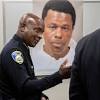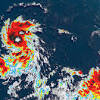What caused the hydrothermal explosion at Yellowstone National ...

Yellowstone National Park visitors were sent running and screaming Tuesday when a hydrothermal explosion spewed boiling hot water and rocks into the air. No one was injured, but it has left some wondering: How does this happen and why wasn't there any warning?
The Weather Channel's Stephanie Abrams said explosions like this are caused by underground channels of hot water, which also create Yellowstone's iconic geysers and hot springs.
"When the pressure rapidly drops in a localized spot, it actually forces the hot water to quickly turn to steam, triggering a hydrothermal explosion since gas takes up more space than liquid," Abrams said Wednesday on "CBS Mornings." "And this explosion can rupture the surface, sending mud and debris thousands of feet up and more than half a mile out in the most extreme cases."
Tuesday's explosion was not that big, Abrams said, "but a massive amount of rocks and dirt buried the Biscuit Basin," where the explosion occurred.
An explosion at Yellowstone National Park surprised visitors, sending them running for safety as hot water, steam, rocks and mud shot dozens of feet into the air.
How do these explosions happen? @WeatherChannel’s @StephanieAbrams explains. https://t.co/jPSD0Jt2aX pic.twitter.com/ziNFO2YzzN
— CBS Mornings (@CBSMornings) July 24, 2024
A nearby boardwalk was left with a broken fence and was covered in debris. Nearby trees were also killed, with the U.S. Geological Survey saying the plants "can't stand thermal activity."
"Because areas heat up and cool down over time, trees will sometimes die out when an area heats up, regrow as it cools down, but then die again when it heats up," the agency said on X.
The USGS said it considers this explosion small, and that similar explosions happen in the national park "perhaps a couple times a year." Often, though, they happen in the backcountry and aren't noticed.
"It was small compared to what Yellowstone is capable of," USGS Volcanoes said on X. "That's not to say it was not dramatic or very hazardous — obviously it was. But the big ones leave craters hundreds of feet across."
The agency also said that "hydrothermal explosions, "being episodes of water suddenly flashing to steam, are notoriously hard to predict" and "may not give warning signs at all." It likened the eruptions to a pressure cooker.
While Yellowstone sits on a dormant volcano, officials said the explosion was not related to volcanic activity.
"This was an isolated incident in the shallow hot-water system beneath Biscuit Basin," the USGS said. "It was not triggered by any volcanic activity."
More from CBS News
Li Cohen is a senior social media producer at CBS News. She previously wrote for amNewYork and The Seminole Tribune. She mainly covers climate, environmental and weather news.


 United States
United States Argentina
Argentina  Australia
Australia  Austria
Austria  Brazil
Brazil  Canada
Canada  Chile
Chile  Czechia
Czechia  France
France  Germany
Germany  Greece
Greece  Italy
Italy  Mexico
Mexico  New Zealand
New Zealand  Nigeria
Nigeria  Norway
Norway  Poland
Poland  Portugal
Portugal  Sweden
Sweden  Switzerland
Switzerland  United Kingdom
United Kingdom 























